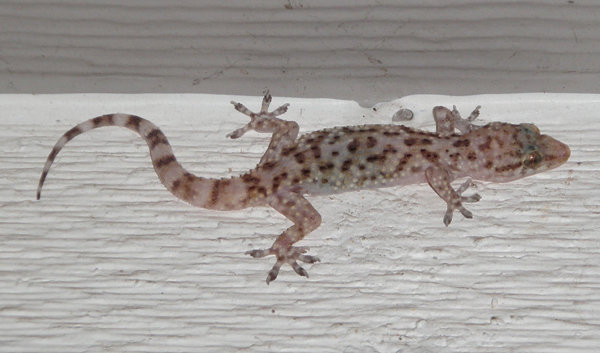
Mediterranean geckos, Hemidactylus turcicus, range in size from one to five inches. To some they are pests, to others welcome guests because of their appetite for insects. Photo E. Brown.
In Texas there are two species of introduced house geckos, the Mediterranean house gecko, Hemidactylus turcicus, and the common house gecko, Hemidactylus frenatus. House geckos are common in suburban and urban areas. Both house gecko species have bulging, lidless eyes with vertical pupils and sticky toe pads.
Identification
Mediterranean house geckos, Hemidactylus turcicus, are an introduced species that can reach lengths of 4-5 inches. They have a rounded snout and bumps on the upper surface of their body (Fig 1.). The tail is cylindrical and slightly flattened and tapers toward the tip and is banded with brown stripes. Mediterranean house geckos are light colored with mottled dark patches.
Common house geckos, Hemidactylus frenatus, reach 3-6 inches in length. They have an elongated snout and have an elongated tail that tapers toward the end. The color ranges from pinkish to grayish and may be marbled with darker patches of color. The underside is usually creamy-white.
Biology
House geckos are tropical and subtropical lizards. These nocturnal creatures are commonly seen near porch lights at night where they wait for insects to eat such as moths, cockroaches and other insects. These geckos may emit a high-pitched call or squeak when alarmed. They often take shelter around structures in crack and crevices.
While geckos are beneficial predators of insects, they may become a nuisance when they move into structures. In addition to being a nuisance, their droppings can stain fabrics, carpets and curtains. Droppings are elongated and brownish, and frequently tipped with white.
Geckos are mostly active spring through fall and frequent lighted areas- windows, porch lights, etc. They may enter structures through cracks and crevices or around doorways. Droppings can stain carpets, rugs, walls, curtains and other object within the home.
Females lay several clutches of two eggs during the summer. Eggs are oval and white. Eggs may be laid in crevices, under bark, in soil or other protected locations.
Control
No pesticides are registered for gecko control. Pesticides used for general insect control may have some effect on gecko numbers by reducing their food supply; however the impact probably will be minimal.
Gecko management should focus on excluding the lizards from the structure. Check and replace weather stripping around doors and windows where needed. Use sealant to close cracks and crevices around soffits and plumbing or electrical penetrations. Geckos commonly use poorly sealed gaps around the home exterior as hiding places during the day. It is important to eliminate as many of these harborages as practical by sealing with silicon caulks or expanding foam sealers.
Geckos can be beneficial in helping to reduce insect numbers so many people choose to have them remain indoors. If you do not want geckos in the house, they can be captured indoors and released back out side as long as you have taken precautions to exclude them from moving back into the structure. A plastic margarine container or other jar can be used to humanely catch and relocate the gecko.
Glue boards and sticky cards, available through do-it-yourself pest control supply stores or pest control companies, will catch and kill geckos. Glue boards should be placed near lights and windows or outdoors surfaces where geckos prefer to congregate. Warning, glue traps are not for the soft-hearted, and does not kill the gecko quickly or allow for a humane release.
Authors:
Michael Merchant, Ph.D., Urban Entomologist, Texas AgriLife Center at Dallas, and Elizabeth Brown, IPM Program Specialist, Travis County AgriLife Extension office.